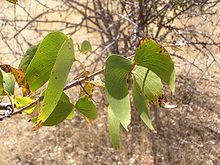Angolan mopane woodlands
| Angolan mopane woodlands | |
|---|---|
Afrotropic | |
| Biome | Tropical and subtropical grasslands, savannas, and shrublands |
| Geography | |
| Area | 133,400 km2 (51,500 sq mi) |
| Countries | |
| Conservation | |
| Conservation status | Critical/Endangered |

Angolan mopane woodlands are situated in southwestern Angola, extending into northern Namibia. This ecosystem surrounds Etosha Pan, which is considered a separate ecoregion. The mopane trees are the main type of vegetation.[1]
Location and description
In Angola the region mostly comprises the southern
The mopane woodlands are bounded on the west by the drier
The Angolan mopane woodlands surround the
Flora
Mopane is the distinctive feature, a single-stemmed tree in some places up to 10 m high and in some places not much more than a shrub. It has butterfly-shaped leaves and grows in dense thickets. In Etosha National Park in Namibia it is by the far the most common species.
Fauna
Threats and preservation
The woodlands are vulnerable to clearance for agriculture, firewood and timber while the grassland between the trees is being overgrazed. On the Angolan side there are two national parks,
Meanwhile in Namibia a huge game reserve contained a large proportion of this ecoregion until the park was broken up to create land for settlements in the 1960s. Part of the reserve remains protected as
Visiting the region
The closest town to Etosha National Park is Tsumeb.
References
- ^ EO Earth Archived March 31, 2009, at the Wayback Machine
- ^ World Wildlife Fund, ed. (2001). "Angolan Mopane woodlands". WildWorld Ecoregion Profile. National Geographic Society. Archived from the original on 2010-03-08.
- ^ Burgess, Neil, Jennifer D'Amico Hales, Emma Underwood, et al. (2004). Terrestrial Ecoregions of Africa and Madagascar: A Conservation Assessment. World Wildlife Fund. Island Press, 2004.
